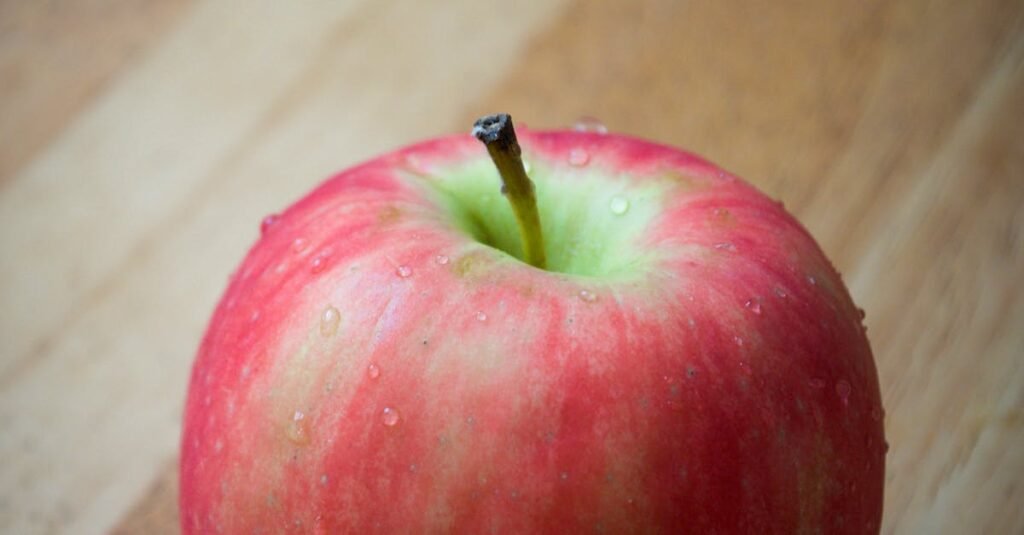# Discover the Surprising Amount of Fiber in an Apple: 5 Key Facts You Didn’t Know!
Apples are often touted as a healthy snack, but how much fiber do they really contain? Understanding the fiber content in apples can help you make informed dietary choices, especially if you’re aiming to increase your fiber intake for better digestion or overall health. In this article, we’ll delve into the details of fiber in apples, provide a comprehensive table, and explore the health benefits associated with this delicious fruit.
| Type of Apple | Serving Size | Fiber Content (grams) |
|---|---|---|
| Medium Raw Apple (with skin) | 1 medium (182g) | 4.4 |
| Large Raw Apple (with skin) | 1 large (223g) | 5.6 |
| Small Raw Apple (with skin) | 1 small (149g) | 3.0 |
| Dried Apple Slices | 1 oz (28g) | 2.7 |
| Apple Sauce (unsweetened) | 1 cup (245g) | 3.6 |
Medium Raw Apple (with skin)
A medium raw apple with skin contains approximately 4.4 grams of fiber. This amount is significant for a single fruit and contributes to the daily recommended fiber intake. The skin is where much of the fiber is located, so it’s best to eat apples unpeeled to maximize fiber consumption. This fiber aids in digestion and helps maintain healthy cholesterol levels.

Large Raw Apple (with skin)
If you opt for a large raw apple, you’ll get about 5.6 grams of fiber. This higher fiber content can be particularly beneficial for those looking to increase their fiber intake without consuming large amounts of food. Fiber-rich diets are associated with numerous health benefits, including improved gut health and a reduced risk of chronic diseases.

Small Raw Apple (with skin)
A small raw apple provides around 3.0 grams of fiber. While this is lower than its larger counterparts, it still contributes positively to your daily fiber goals. Smaller apples can be a great option for a quick snack, especially for children or those with smaller appetites.

Dried Apple Slices
Dried apple slices offer about 2.7 grams of fiber per ounce. While drying fruit can concentrate some nutrients, it’s important to be mindful of portion sizes since dried fruits can be calorie-dense. They make a great addition to trail mixes or as a topping for oatmeal, providing a chewy texture along with fiber.

Apple Sauce (unsweetened)
Unsweetened apple sauce contains approximately 3.6 grams of fiber per cup. It serves as a versatile ingredient in many recipes, acting as a natural sweetener and moisture enhancer in baked goods. Moreover, it provides a softer alternative for those who may have difficulty chewing whole fruits while still delivering fiber benefits.

FAQ
How much fiber do apples provide compared to other fruits?
Apples are a good source of fiber, but their fiber content can vary when compared to other fruits. For instance, a medium-sized pear has about 5.5 grams of fiber, while a banana has about 3.1 grams. Apples offer a moderate amount of fiber, making them a great option in a balanced diet alongside other fruits.
What are the health benefits of consuming fiber from apples?
Fiber from apples can aid in digestion, help regulate blood sugar levels, and promote feelings of fullness, which can assist in weight management. A fiber-rich diet is also linked to lower risks of heart disease, type 2 diabetes, and certain types of cancer. Additionally, the soluble fiber found in apples, known as pectin, can help lower cholesterol levels.
Can I get fiber from apples if I eat them without the skin?
Yes, you can still obtain some fiber from apples if you eat them without the skin, but you will miss out on a significant portion. The skin contains the majority of the fiber, so it is recommended to consume apples with their skin intact for maximum health benefits.
How can I include more apples in my diet?
There are numerous ways to incorporate apples into your diet. You can enjoy them raw as a snack, add slices to salads, make apple sauce, bake them into desserts, or even blend them into smoothies. Their versatility makes them easy to include in various meals throughout the day.
Are there any downsides to eating too many apples?
While apples are healthy, consuming them in excess may lead to digestive discomfort due to their fiber content. Additionally, apples contain natural sugars, so moderation is key, especially for individuals managing blood sugar levels. A balanced diet with a variety of fruits and vegetables is always recommended.
For more detailed information on dietary fiber and its benefits, you can visit the [U.S. Department of Agriculture](https://www.usda.gov) and [National Institutes of Health](https://www.nih.gov). These resources provide comprehensive dietary guidelines and research on nutrition.
In conclusion, apples are not only delicious but also a fantastic source of dietary fiber. Whether you prefer them raw, dried, or as sauce, including apples in your diet can contribute significantly to your overall health and well-being.


